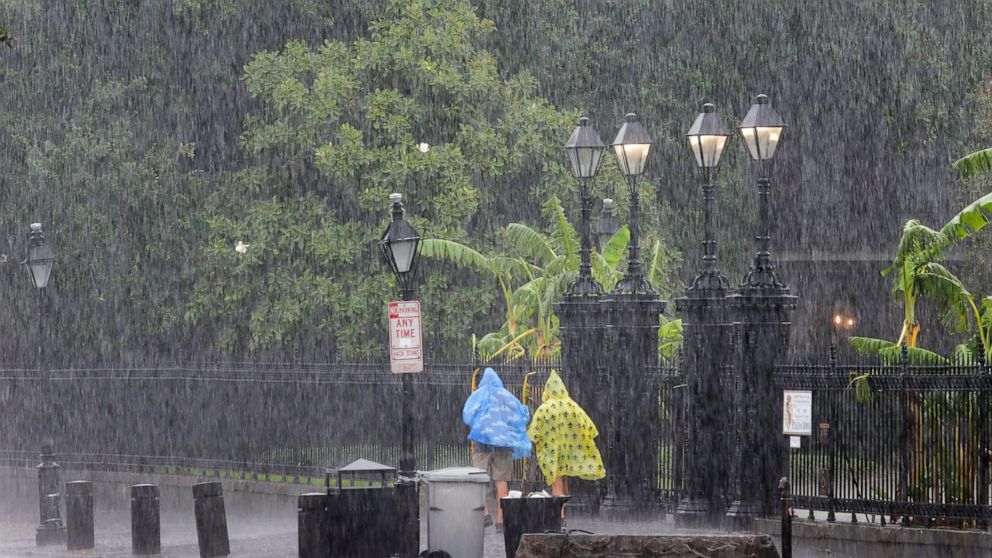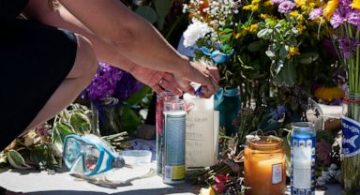
The Latest on Barry (all times local):
3:25 p.m.
Beaches along the Mississippi Gulf Coast remain closed because of toxic bacteria detected before Barry blew ashore.
Polluted Midwest floodwaters have fed an outbreak of cyanobacterium. Commonly known as blue-green algae, it can cause rashes, diarrhea and vomiting. It has spread eastward as water from the Mississippi River pours into the Gulf of Mexico.
Mississippi Department of Environmental Quality spokesman Robbie Wilbur says Monday the agency is continuing to test water samples. He says those tested Sunday “indicated the continued presence of algal bloom.”
The agency started closing some beaches June 22 along Mississippi’s mainland Gulf Coast. On July 7, it closed the last two sections near the Alabama line. Although the water is off limits, people can still be on the sand.
Mississippi’s barrier islands’ beaches have remained open.
———
3 p.m.
Tropical Depression Barry is moving through Arkansas but it isn’t quite done with Louisiana.
Rain generated by Barry was still moving across the state from the southwest to the northeast on Monday afternoon.
Mayor Gene Paul estimated his small southwest city Louisiana of Oakdale got about 14 inches (35.5 centimeters) of rain overnight. He was spending Monday collecting information on homes and businesses that flooded.
Dick Gremillion (GREH’-mih-ahn), the emergency management director in Calcaseiu (KAL’-kuh-shoo) Parish estimates as much as 17 inches (43 centimeters) of rain fell north of the city of Lake Charles overnight. He said 18 people sought refuge from rising water in the parish.
In Evangeline Parish, north of Lafayette, KLFY television showed scenes of water-covered streets and flooded cars in the town of Ville Platte.
———
12:45 p.m.
Amtrak rail service between New Orleans and three major cities is being restored after being suspended while Barry threatened.
The Amtrak Crescent was to leave New York for New Orleans on Monday, with service from New Orleans to New York resuming Tuesday.
Amtrak’s Sunset Limited trains connect Los Angeles and New Orleans. The railroad says eastbound service to New Orleans resumes Wednesday. Westbound service resumes Saturday.
Service on Amtrak’s City of New Orleans is being partially restored with a Monday night trip from Chicago to Jackson, Mississippi, and a Tuesday departure from Jackson to Chicago. Chartered buses will shuttle Amtrak passengers between New Orleans and Jackson, for now. Amtrak’s news release say the freight railroad that owns the route between those cities has temporarily closed that segment.
———
11:30 a.m.
The National Weather Service says that Barry has dumped as much as a foot to a foot-and-a-half (30 to 46 centimeters) of rain in some parts of Louisiana since it moved in several days ago.
In a bulletin warning of flash flooding, forecasters said much of Monday’s heaviest rain fell in areas just north of Lake Charles, Louisiana. Authorities say rivers and streams are rising quickly in that part of the state.
In Mississippi, Barry has brought 3 to 7 inches (8 to 18 centimeters) of rain to many areas.
Barry crawled onto the Louisiana coast as a hurricane on Saturday, quickly weakening into a tropical storm and later a tropical depression. It was moving slowly north through Arkansas on Monday.
In a tweet Monday, Mississippi Gov. Phil Bryant remarked that the South Delta “has become an ocean.” He’s calling on the federal government to build pumps to drain water from the confluence of the Yazoo and Mississippi Rivers.
———
9:50 a.m.
Authorities say rains from Barry overwhelmed sewer systems on Alabama’s coasts, causing more than 250,000 gallons (946,000 liters) in spills.
The Alabama Department of Public Health says more than 180,000 gallons (680,000 liters) of sewage spilled in Baldwin County, located across Mobile Bay from the city of Mobile.
An estimated 125,000 gallons (470,000 liters) went into D’Olive Creek in Daphne. The state says spills also are being reported in Fairhope and Bay Minette.
The Mobile Area Water and Sewer System says about 80,680 gallons (305,000 liters) of sewage went into three creeks in the city.
The state is telling coastal residents to stay out of the waterways. It also says that any seafood caught in the area should be cooked thoroughly before consumption.
———
8:25 a.m.
Forecasters say more than a foot (30 centimeters) of rain has fallen in parts of Louisiana, prompting new flash flood warnings in that state and in Mississippi as the remnants of Barry inch north through the nation’s midsection.
The National Weather Service issued multiple flash flood warnings Monday morning in Louisiana and Mississippi.
Forecasters said up to 14 inches (36 centimeters) of rain had already fallen some spots in southwest Louisiana.
Monday’s rainfall was among the heaviest seen so far after Barry struck Louisiana over the weekend as a weak hurricane.
———
1:20 a.m.
Even though Tropical Depression Barry did not unleash catastrophic flooding in Louisiana, many across the Gulf Coast were urged to take heed of tornado and flash-flood warnings Monday as the storm moved north.
Barry was downgraded from a tropical storm on Sunday afternoon but continued to pose a threat. Much of Louisiana and Mississippi were under flash-flood watches, as were parts of Arkansas, eastern Texas, western Tennessee and southeastern Missouri.
Louisiana Gov. John Bel Edwards urged residents to be cautious as they ventured outside after a weekend in which many had sheltered indoors.
He says he was “extremely grateful” that the storm had not caused the disastrous floods that had earlier been forecast.
According to poweroutage.us, about 60,000 customers in Louisiana and 3,300 customers in Mississippi were without power Sunday night.
———
For the latest on Tropical Storm Barry, visit https://apnews.com/Hurricanes .





